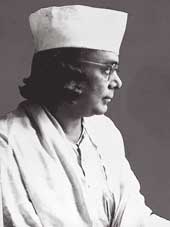Related Research Articles

Badakhshan is a historical region comprising parts of modern-day north-eastern Afghanistan, eastern Tajikistan, and Taxkorgan Tajik Autonomous County in China. Badakhshan Province is one of the 34 provinces of Afghanistan. Much of historic Badakhshan lies within Tajikistan's Gorno-Badakhshan Autonomous Region, in the southeastern part of the country. The music of Badakhshan is an important part of the region's cultural heritage.

Bengali poetry is a rich tradition of poetry in the Bengali language and has many different forms. Originating in the Bengal region of South Asia, the history of Bengali poetry underwent three successive stages of development: poetry of the early age, the Medieval period and the age of modern poetry. All ages have seen different forms of poetry and poetical tradition. It reached the pinnacle during the Bengali Renaissance period although it has a rich tradition and has grown independent of the movement. Major Bengali Poets throughout the ages are Chandidas, Alaol, Ramprasad Sen, Michael Madhusudan Dutt, Nabinchandra Sen, Rabindranath Tagore, Dwijendralal Ray, Satyendranath Dutta, Kazi Nazrul Islam, Jibanananda Das, Jasimuddin, Sukanta Battacharya, Al Mahmud.

Pakistani folklore encompasses the mythology, poetry, songs, dances and puppetry from Pakistan's various ethnic groups.

The Pashto media includes Pashto literature, Pashto-language newspapers, magazines, television and radio stations, as well as Pashto films and Pashto internet. Pashto media involves the Pashtuns of Pakistan, Afghanistan and the Pashtun diaspora around the world.
Sindhi literature, is the composition of oral and written scripts and texts in the Sindhi language in the form of prose: and poetry:. The Sindhi language of the province of Sindh in Pakistan is considered to be the one of the oldest languages of Ancient India, due to the influence on the language of Indus Valley inhabitants. Sindhi literature has developed over a thousand years.

Pashto literature refers to literature and poetry in Pashto language. The history of Pashto literature spreads over five thousands years having its roots in the oral tradition of tapa. However, the first recorded period begins in 7th century with Amir Kror Suri. Later, Pir Roshan (1526–1574), who founded his own Sufi school of thoughts and began to preach his beliefs. He gave Pashto prose and poetry a new and powerful tone with a rich literary legacy. Khair-ul-Bayan, oft-quoted and bitterly criticized thesis, is most probably the first book on Sufism in Pashto literature. Among his disciples are some of the most distinguished poets, writers, scholars and sufis, like Arzani, Mukhlis, Mirza Khan Ansari, Daulat and Wasil, whose poetic works are well preserved. Akhund Darweza (1533–1615), a popular religious leader and scholar gave a powerful counterblast to Bayazid’s movement in the shape of Makhzanul Islam. He and his disciples have enriched the Pashto language and literature by writing several books of prose.

Alakozai is the name of a Pashtun tribe in Afghanistan. Spelling variations include Alakozi, Alakoozi, Alekozai, Alekuzei, Alikozai, Alokozay, Alokozay, Alkozai, Alokzai, Hulakozai, Alecozay, Alikusi, and Alakuzei. They are one of the four tribes of the Zirak tribal confederacy of Durrani Pashtuns.
Multan in Punjab province of Pakistan is one of the oldest cities in South Asia, though its exact age has yet to be determined. Multan is known for its ancient heritage and historic landmarks, it has remained the capital of Punjab region in ancient and medieval eras.It has seen a lot of warfare because of its location on a major invasion route between South and Central Asia. It is famous for its Sufi shrines. It was restored in the 1100s.
Punjabi literature, specifically literary works written in the Punjabi language, is characteristic of the historical Punjab of India and Pakistan and the Punjabi diaspora. The Punjabi language is written in several scripts, of which the Shahmukhi and Gurmukhī scripts are the most commonly used in Pakistan and India, respectively.
Pandit Taba Ram Turki lived at Rainawari, Srinagar and wrote Persian poetry under the pen name (takhalus) of Betab. Betab made an important contribution to the Persian poetry and he commanded great respect among the poets of Kashmir of his time. Betab was an exceptional poet whose Persian poetry reached as far as Central Asia. Some critics have rated Betab's works at par with the Shahnama of Firdausi. Betab was also proficient with reading and writing Arabic.
Habibia High School is a school in southwestern Kabul, Afghanistan which has educated many of the former and current Afghan elite, including President Ashraf Ghani and musician Ahmad Zahir. It was founded by King Habibullah Khan in 1903.
The Battle of Nowshera was fought in Nowshera in March 1823 between the Yusufzai Afghans, supported by the Peshawar sardars, alongside Azim Khan Barakzai, the Afghan governor of Peshawar, where they would face the Sikh armies led by Maharaja Ranjit Singh. Azim Khan was a half-brother of Dost Mohammad Khan, future ruler of Kabul, and later Afghanistan. The battle was a victory for the Sikhs, successfully defeating Azim Khan's armies. This victory allowed them to begin to their occupation of the Peshawar Valley.
Punjabi Muslims are adherents of Islam who identify linguistically, culturally, and genealogically as Punjabis. Primarily geographically native to the Punjab province of Pakistan today, many have ancestry in the entire Punjab region, split between India and Pakistan in the contemporary era.
A Bengali Kissa, also known as Keccha, is a genre of Bengali poetry and prose as well as a tradition in the Bengali language of oral story-telling. It started flourishing in Bengal with the fusion of local Bengali folklore and stories from the Arab and Turco-Persian immigrants. The art form remains popular amongst the rural Muslim communities of Bangladesh.
References
- 1 2 Datta, Amarest (1988). Encyclopaedia of Indian Literature. Heroic literature (Punjabi): Sahitya Akademi (New Delhi, Inde). p. 1570. ISBN 8126011947.
- ↑ "Nand Singh and Jangnamah Europe: Subaltern insights on the wars of Empire". South Asia @ LSE. 2017-04-05. Retrieved 2017-04-14.